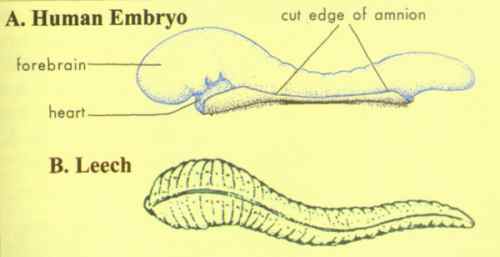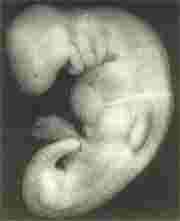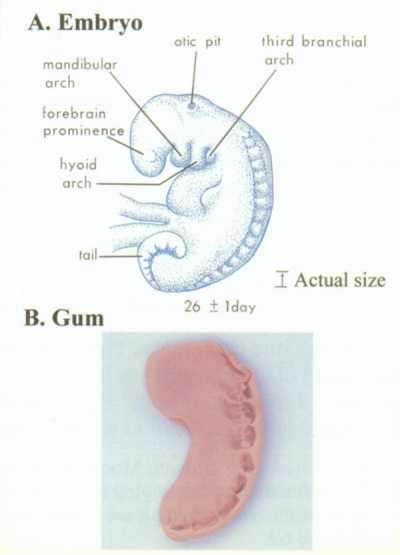|
|
|
|
|
Literally the Arabic word Alaqah
has three meanings :
figure 1: Drawing illustrating the similarities in appearance between a leech and a human embryo at at alaqah stage  figure 2: We can see in this diagram the suspension of an embryo during the alaqah stage in the womb (uterus of the mother).  figure 3: We can see in this photomicrograph the suspension of an embryo (marked B) during the alaqah stage (about 15 days old) in the womb of the mother. The actual size of the embryo is about 0.6mm.  The third meaning of the word alaqah is
"blood clot". We find that the external appearance of the embryo and its
sacs during the alaqah stage is similar to that of blood clot. this is
due to the presence of relatively large amounts of blood present
in the embryo during this stage (in figure 4). Also during this stage,
the blood in the embryo does not circulate until the end of the third week.
Thus the embryo at this stage is like a clot of blood.
figure 4: Diagram of the primitive cardiovascular system in an embryo
during the alaqah stage. The external appearance of the embryo and its
sacs is similar to that of a blood clot due to the presence of relatively
large amounts of blood present in the embryo.
|
The next stage mentioned in the verse is
the mudgah stage. The Arabic word mudgah means
"chewed-like-substance". If one were to take
a piece of gum and chew it in his mouth, and then compare it to the embryo
at the mudgah stage, we would conclude that the embryo at the mudgah
stage acquires the appearance of a chewed-like substance because of the
somites at the back of the embryo that "somewhat resemble teethmarks in
a chewed substance".
See figure 5 and 6
figure 5: Photograph of an embryo at the mudgah stage
(28 days old). The embryo at this stage acquires the appearance of a chewed-like
substance, because of the somites at the back of the embryo, somewhat resemble
teeth marks on a chewed substance. The actual size of the embryo is 4mm.
(The developing human, Moore and Persaud)

figure 6: When comparing the appearance of an embryo at the mudgah
stage with a piece of gum that has been chewed, we find similarity between
the two
A) Drawing of an embryo at the mudgah stage. We can see here
the somites at the back of the embryo that look like teeth marks.
B) Photograph of a piece of gum that has been chewed.

Professor Keith Moore is one of the world's prominent scientists in the fields of anatomy and embryology and is the author of the book entitled "The Developing Human", which has been translated into eight languages. The book is considered a scientific reference work and was chosen by the special committee in the United States as the best book authorised by one person. Dr. Keith Moore is the Professor of Anatomy and cell biology at the university of Toronto, Toronto, Canada. In 1984, he received the most distinguished award presented in the field of anatomy in Canada, the J.C.B. Grant Award from the Canadian association of Anatomists. He has directed many international associations such as the Canadian and American Association of Anatomists and the council of the Union of Biological Sciences.
In 1981, during the seventh Medical conference in Dammam, Saudi Arabia, Professor Moore said, " It has been a great pleasure for me to help clarify statements in the Quran about Human development. It is clear to me that these statements must have have come to Mohammad from God, or Allah, because almost all of this knowledge was not discovered until many centuries later. This proves to me that Mohammad must have been a messenger of God, or Allah."
Consequently, Professor Moore was asked the following question. " Does this mean that you believe that the Quran is the Word of Allah?" He replied : " I find no difficulty in accepting this."
During one conference, Professor Moore stated,
"....Because the stating of human embryos is complex, owing to the continous
process of change during development, it is proposed that a new system
of classification could be developed using the terms mentioned in the Quran
and Sunnah (what Mohammad said, did or approved of). The proposed
system is simple, comprehensive, and comforms with embryological knowledge.
The intensive studies of the Quran and Hadeeth (reliably transmitted
reports by the Prophet Mohammad's companions of what he said, did or approved
of) in the last four years have revealed a system of classifying human
embryos that is amazing since it was recorded in the seventh century A.D.
Although Eric Statle, the founder of the science of embryology, realized
that chick embryos developed in stages from his study of hen's eggs in
the fourth century B.C., he did not give any details about these stages.
As far as it is known from the history of embryology, little was known
about the staging and classification of human embryos until twentieth century.
For this reason the, the descriptions of the human embryo in the Quran
cannot be based on scientific knowledge in the seventh century. The only
reasonable conclusion is that these descriptions were revealed to Mohammad
from God. He could not have known such details because he wan an illiterate
man with absolutely no scientific training."
Imran Ahmad Ali
imr@digicron.com